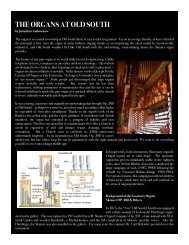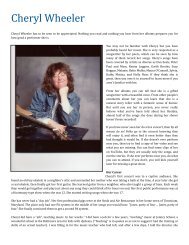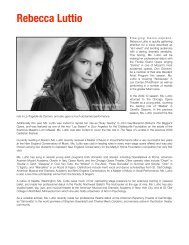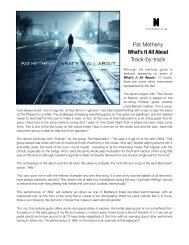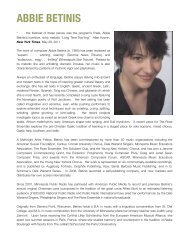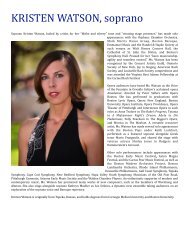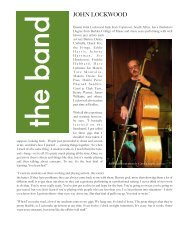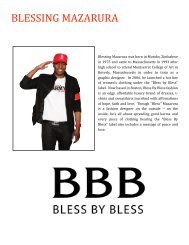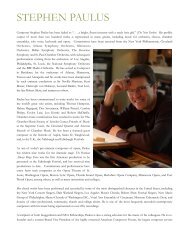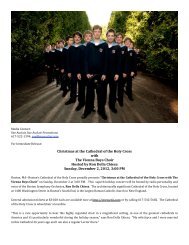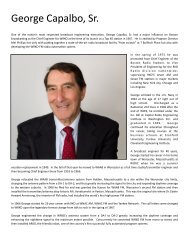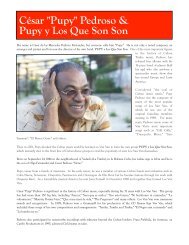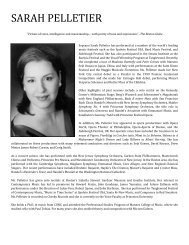WAYNE SHORTER - Sue Auclair Promotions
WAYNE SHORTER - Sue Auclair Promotions
WAYNE SHORTER - Sue Auclair Promotions
You also want an ePaper? Increase the reach of your titles
YUMPU automatically turns print PDFs into web optimized ePapers that Google loves.
<strong>WAYNE</strong> <strong>SHORTER</strong><br />
Wayne Shorter's background is inextricably linked to<br />
the history of modern music. Shorter was born in 1933<br />
in Newark, New Jersey and studied visual art at the<br />
Arts High School there, but was attracted to music<br />
and began playing the clarinet at the relatively late age<br />
of fifteen. "I liked the storytelling role of the clarinet<br />
that I heard on compositions like "Scheherezade",<br />
Shorter remembers. "It was just glowing with<br />
possibility there in the shop window, with its shiny<br />
silver keys."<br />
He graduated to the tenor saxophone when he was<br />
seventeen, and within a couple years his brilliant<br />
playing on the horn had earned him the nickname<br />
"The Newark Flash" across the river in Manhattan.<br />
He joined up with Art Blakey's Jazz Messengers in<br />
1959, and it wasn't long before Shorter began gaining<br />
notice as a composer and was promoted to "musical<br />
director" of the Messengers.<br />
When Shorter joined the Miles Davis band in 1964,<br />
his writing was vital to establishing the sound of that<br />
classic quintet with Herbie Hancock, Ron Carter,<br />
and Tony Williams. Davis typically reworked the<br />
compositions of his sidemen but granted Shorter rare autonomy: "When I wrote stuff Miles would say, 'There's no need to<br />
change any of Wayne's music. It's all there.'"<br />
While recording prodigiously as a leader on his own Blue Note dates, Shorter continued to work with Miles. When he<br />
followed Miles on his excursions into electric jazz, he adopted the soprano saxophone as a second instrument, winning the<br />
best soprano category in DownBeat magazine Readers Poll for seventeen years. Shorter co-founded Weather Report with<br />
Joe Zawinul, and he enlarged his compositional canvas with sprawling fusion works that succeeded commercially as well as<br />
artistically--1977's Heavy Weather went gold.<br />
In the '80s and '90s Shorter worked on several soundtracks, and lent his finesse to the pop music of Steely Dan, Joni Mitchell,<br />
and Carlos Santana, among others. He recorded several solo albums for Columbia Records, and then two Grammy® awardwinning<br />
records for Verve: High Life in 1995, and 1+1, a 1997 duo recording with longtime associate Herbie Hancock.<br />
Bassist John Pattitucci says that Shorter possesses the prowess of many classical composers combined. "Wayne's got a feel for<br />
the melody, like Puccini, on an extremely high level, but he's also got the harmonic complexity, like Ravel. He's got a bunch of<br />
stuff going on at the same time."<br />
sueauclair.com
Shorter showcases his growth as a composer with reworkings of some of his older material, including "Capricorn", "Orbits",<br />
and "Angola", a tune he originally recorded at one of his 1965 Blue Note sessions. In its earlier incarnation, "Angola" sped<br />
along, tight and swinging. Here, with layered African rhythms opening up the tune vertically and a horn chorus broadening<br />
the melody, Angola is reharmonized and restructured into an entirely new sound.<br />
"You don't have to be governed or restricted by playing solos on a 'prefabricated" harmony,' Shorter says. "When we have one<br />
harmony start off and it doesn't have to come around a second or third time, you're not restricted, and you start to create a<br />
new drama extemporaneously, right on the spot, not really knowing where it's going to go."<br />
2003 ALEGRIA<br />
After serving as one the principal architects of jazz for over forty years, saxophonist and composer Wayne Shorter has<br />
developed some lofty goals for his music. "At this point I'm looking to express eternity in composition," he says. "I'm striving<br />
to open up those people who aren't used to thinking in those<br />
terms."<br />
Fittingly, AlegrÌa, his first all-acoustic studio recording as a<br />
leader since 1967, finds him working with a rich and broad<br />
palette of orchestral colors, including percussion, brass,<br />
woodwinds, and strings and drawing upon musical inspirations<br />
that span the past millennium. AlegrÌa features a traditional<br />
Celtic folk song, a Bach-inspired piece by the modern Brazilian<br />
classical master Heitor Villa-Lobos, a popular Spanish song of<br />
the 1960s-alongside radical re-workings of some of his own<br />
famed compositions from the 1960s, and one new work, the<br />
smoking boogaloo "Sacajawea."<br />
Shorter says he's worked to achieve his panoramic perspective:<br />
"The key thing about this album is that it represents an ongoing<br />
process of me learning how to get out of my own way. Tiger<br />
Woods once said that he lost a golf match because he was in his<br />
own way. Imagine if Beethoven had gotten in his own way-he would have written all his major symphonies for himself as a<br />
concert pianist! When you're modest enough, it broadens your perspective, and you can be free to do anything."<br />
Any recording from the internationally acclaimed jazz figure is eagerly anticipated, but AlegrÌa has special significance as it<br />
comes on the heels of the phenomenally successful Footprints live! This 2002 release was Shorter's premier live recording,<br />
documenting the first time he had ever toured as the leader of his own acoustic group. The quartet is comprised of some<br />
stellar young musicians, Danilo Perez, John Patitucci, and Brian Blade, who each put aside their own highly respected bands<br />
to tour with Shorter. Footprints live! earned a Grammy nomination for Best Jazz Instrumental Album and was universally<br />
lauded. The record topped "Best of 2002" lists in The New York Times and The Los Angeles Times, and won a rare five<br />
stars from DownBeat magazine. European press rivaled that enthusiastic response: the Academy of Arts in France named<br />
Footprints live! Best Jazz Album, and Italy awarded the record three top prizes.<br />
sueauclair.com
AlegrÌa was recorded in advance of the Footprints live! tour, and includes three selections with his hit quartet, which critics,<br />
musicians, and fans are calling the "best small group in jazz." "This recording was really the only rehearsal we had," Shorter<br />
says. "The seeds of Footprints live!, its initiation, is subtly evidenced in some of this studio music. After we finished recording<br />
in the studio, we were able to build from there with the tour and create the stories you hear on the road."<br />
With the assistance of producer Robert Sadin, (Herbie Hancock's Gershwin's World), Shorter drafted the quartet members,<br />
and several other creative young players as collaborators, including drummer Terri Lyne Carrington and pianist Brad<br />
Mehldau. On four tracks a sure sense of groove is supplied by Alex AcuÒa, the percussionist who played with Shorter and<br />
Joe Zawinul in Weather Report.<br />
Wayne Shorter's own background is inextricably linked to the history of modern music. Shorter was born in 1933 in Newark,<br />
New Jersey and studied visual art at the Arts High School there, but was attracted to music and began playing the clarinet at<br />
the relatively late age of fifteen. "I liked the storytelling role of the clarinet that I heard on compositions like "Scheherezade",<br />
Shorter remembers. "It was just glowing with possibility there in the shop window, with its shiny silver keys."<br />
He graduated to the tenor saxophone when he was seventeen, and within a couple years his brilliant playing on the horn had<br />
earned him the nickname "The Newark Flash" across the river in Manhattan. He joined up with Art Blakey's Jazz<br />
Messengers in 1959, and it wasn't long before Shorter began gaining notice as a composer and was promoted to "musical<br />
director" of the Messengers.<br />
When Shorter joined the Miles Davis band in 1964, his writing was vital to establishing the sound of that classic quintet with<br />
Herbie Hancock, Ron Carter, and Tony Williams. Davis typically reworked the compositions of his sidemen but granted<br />
Shorter rare autonomy: "When I wrote stuff Miles would say, 'There's no need to change any of Wayne's music. It's all<br />
there.'"<br />
While recording prodigiously as a leader on his own Blue Note dates, Shorter continued to work with Miles. When he<br />
followed Miles on his excursions into electric jazz, he adopted the soprano saxophone as a second instrument, winning the<br />
best soprano category in DownBeat magazine Readers Poll for seventeen years. Shorter co-founded Weather Report with<br />
Joe Zawinul, and he enlarged his compositional canvas with sprawling fusion works that succeeded commercially as well as<br />
artistically-1977's Heavy Weather went gold.<br />
In the '80s and '90s Shorter worked on several soundtracks, and lent his finesse to the pop music of Steely Dan, Joni Mitchell,<br />
and Carlos Santana, among others. He recorded several solo albums for Columbia Records, and then two Grammy awardwinning<br />
records for Verve: High Life in 1995, and 1+1, a 1997 duo recording with longtime associate Herbie Hancock.<br />
AlegrÌa synthesizes many aspects of Shorter's career into a forward-thinking retrospective of musical languages and styles. Of<br />
the record's style, Shorter jokes, "I'd call it impressionistic, but don't want to say French impressionism, cause they put a big<br />
price tag on that."<br />
Bassist John Pattitucci says that Shorter possesses the prowess of many classical composers combined. "Wayne's got a feel for<br />
the melody, like Puccini, on an extremely high level, but he's also got the harmonic complexity, like Ravel. He's got a bunch of<br />
stuff going on at the same time."<br />
sueauclair.com
Shorter showcases his growth as a composer with reworkings of some of his older material, including "Capricorn", "Orbits",<br />
and "Angola", a tune he originally recorded at one of his 1965 Blue Note sessions. In its earlier incarnation, "Angola" sped<br />
along, tight and swinging. Here, with layered African rhythms opening up the tune vertically and a horn chorus broadening<br />
the melody, Angola is reharmonized and restructured into an entirely new sound.<br />
"You don't have to be governed or restricted by playing solos on a 'prefabricated" harmony,' Shorter says. "When we have one<br />
harmony start off and it doesn't have to come around a second or third time, you're not restricted, and you start to create a<br />
new drama extemporaneously, right on the spot, not really knowing where it's going to go."<br />
One of the record's most beautifully realized tunes is Villa-Lobos's "Bachianas Brasileiras No. 5", which was arranged by<br />
Sadin. On the piece, a plucked cello chorus seems to be holding court for Alex AcuÒa's Afro-Brazilian percussion. Shorter's<br />
tenor improvisation, a study in moody refinement, offers a contrapuntal foil to the cello's statement of the famous melody.<br />
Some of the selections on AlegrÌa came to Shorter quite serendipitously. A few years ago Shorter discovered some sheet<br />
music tucked away in a piano bench, including "12th Century Carol", a choral piece he sang as a student at New York<br />
University. The medieval carol blossoms here with Shorter's groove-based variations.<br />
From the same "time capsule" piano bench Shorter exhumed "Vendiendo AlegrÌa", a 1930s flamenco tune popularized by<br />
Spanish singer Antonio Molina and Orquestra Montillo. Miles Davis gave Shorter the music in the mid-'60s, suggesting that<br />
he "do something with it."<br />
"As I started investigating the tune," Shorter says, "I was struck by how simplistic the melody was, and I wanted to celebrate<br />
it with an arrangement that would have it grow." Shorter applied some of Miles Davis's lessons in the tune's rearrangement.<br />
"When Miles would change things in existing compositions, mostly he would take out notes, notes, notes, notes to let all the<br />
jazz ditties out. Miles would make space for them. Space has its own groove and swing."<br />
Shorter points out that the word "space" can have multiple associations, and connects its interplanetary meaning to his<br />
defining vision for AlegrÌa: "If you get into an aircraft and go a certain distance from the earth and turn on a sound device,<br />
you'd hear all different cultures and sounds going on at the same time. That's something like what I'm trying to do on<br />
AlegrÌa; there is presence yet not intrusion; consonance yet not complete unity. And you've got to keep it all grooving; that's<br />
another challenge right there."<br />
One of the most grooving tunes on AlegrÌa is the lead track, "Sacajawea," a new Shorter composition. Its boogaloo feel is in<br />
the tradition of "Sidewinder", the classic tune by his onetime Jazz Messengers bandmate Lee Morgan. As for the<br />
expectations the title might set up, Shorter says, "It doesn't have the ceremonial sound you'd typically associate with Indians<br />
in a Western film. This could be an expression of Native American children, playing to surprise each other. The recurring<br />
melody is about tenacity, and the shout-out at the end is an ultimate declaration of affirmation."<br />
Shorter's description of "Sacajawea" is true of his overall artistry. His music transcends genre while keeping the<br />
improvisational genius and surprise of jazz burning at the center. Shorter celebrates his 70th birthday in 2003. Inspired by the<br />
younger members of his quartet, he's creating some of the most powerful music of his career. Shorter's childlike imagination<br />
and ceaseless innovation in music invite comparison to the enduring vitality of Picasso in the world of art or of Bergman in<br />
film.<br />
sueauclair.com
This exquisite and moving recording is a towering peak in Shorter's outstanding career, and will no doubt garner more<br />
success for the composer and performer. For Wayne Shorter, the secret to that success is finding AlegrÌa or "joy" in<br />
continued creativity: "It's not how far can you go on any given record, it's where you can go after it's done. Happiness is a<br />
work in progress."<br />
2005: BEYOND THE SOUND BARRIER<br />
As a follow-up to 2003's double Grammy® Award-winning Alegria, saxophonist-composer Wayne Shorter returned with<br />
another exhilarating live document that captures the risk-taking chemistry of his celebrated quartet on tour. Beyond the<br />
Sound Barrier continues the remarkable group-think and<br />
deconstructivist aesthetic that Shorter established with<br />
pianist Danilo Perez, bassist John Patitucci and<br />
drummer Brian Blade on 2002's acclaimed Footprints<br />
Live!, Shorter's first all-acoustic foray since his early ’60s<br />
Blue Note years.<br />
Says the bandleader of his highly interactive unit: “We’re<br />
playing a similar outline in different cities, but we’re<br />
getting further and further away from anything sounding<br />
the same from night to night. These guys all have that<br />
kind of forward-looking attitude. They understand that<br />
it’s OK to be vulnerable, to open oneself and take<br />
chances, and not be afraid of the unknown. So if<br />
somebody feels like they want to bring something else to<br />
it, they do it. We don’t have any mandates in this band.<br />
Our attitude is, ‘Let’s paint in watercolors, use good oils<br />
or get white-out, if that’s what you want to use.’”<br />
In typical Shorter fashion, the conversational title track to Beyond the Sound Barrier carries a certain intellectual heft and scifi<br />
expansiveness to it. Likewise, “Adventures Aboard the Golden Mean” refers to that mysterious natural proportion used in<br />
art, architecture and music by the likes of Leonardo Da Vinci, Debussy, Bartok and Beethoven, but Shorter puts a sci-fi twist<br />
to it. “The golden mean is neither captive to the right, left, east, west, north, south or the middle,” says Shorter. “It is attached<br />
to no extreme. That’s a place to try to get to in terms of freedom of thought and choice and all that stuff. And I think it has<br />
nothing to do with an almighty power or anything like that, but a place that we have inside us that’s just asleep a little bit. And<br />
I’m thinking of it like a spaceship called the Golden Mean. I picture a lot of kids on there flying around, having a good time.<br />
And they’re going somewhere along the Golden Mean."<br />
The collection opens with an open-ended take on Arthur Penn's “Smilin’ Through,” which inveterate film buff Shorter dug up<br />
from the deeper recesses of his memory. As he explains, “That’s an old Irish song that was used in a movie with Jeanette<br />
MacDonald and Brian Ahearn. At some point in the movie she’s at the piano and she plays this song, ‘Smilin’ Through.’ The<br />
message of the tune is, whenever a tragedy comes, can you smile through it? And that stuck with me.” Shorter on soprano is<br />
pushed to some ecstatic heights on this tune by Blade's powerhouse traversing of the kit.<br />
“As Far As The Eyes Can See” opens with a free-flowing four-way conversation with Shorter on tenor and gradually evolves<br />
sueauclair.com
into a remarkable example of group improv. The piece actually developed from a fragment that originally appeared in “Go”<br />
from the Footprints album. “It’s like a tag that becomes a piece of music,” says Shorter. “You only hear it one time (on ‘Go’).<br />
There’s only two measures and it stops, but this one takes on a whole other harmonic thing and it’s more of an experience of<br />
the eye . . . how far are you willing to see? People who say they don’t feel<br />
Wayne Shorter Quartet biography – page 2<br />
this or that — they don’t feel classical or they don’t feel country, or all they feel is country. all they want is the safety zone or<br />
comfort zone, what they can relate to and everything. Well, I say, if your feelings are only red, blue and yellow, how far can you<br />
extend yourself in a world that needs extending today?”<br />
Felix Mendelssohn’s “On Wings of Song” is a piece that caught Wayne’s ear in 1995. “I still lived in California then and I was<br />
driving home when I started thinking about old movies I had seen, and this song popped into my head. It was from a western<br />
movie . . . something with the fort, the Union soldiers, and they were having a ball. John Wayne would be waltzing with<br />
Maureen O’Hara with this song would be playing in the background. So when this song came to me, I stopped the car, found<br />
a piece of paper and wrote down the first few notes so I wouldn’t forget that I thought about it.” Shorter's tenor sax<br />
investigates the simple melody here and is underscored by Perez's chamber-like aesthetic on piano and Patitucci's buoyantly<br />
interactive groove.<br />
The ethereal “Tinker Bell” is distinguished by a freewheeling conversation between Perez's piano and Patitucci's bowed bass<br />
while the more turbulent “Joy Ryder” is anchored by Blade's muscular yet flexible backbeat and Patitucci's deep, minimalist<br />
groove. Shorter stretches out on soprano sax on this remake of the title track from his 1988 Columbia album. The quartet's inthe-moment<br />
extrapolation here is yet another great example playful group improv. "Over Shadow Hill Way" (also from 1988's<br />
Joy Ryder) gets a looser, more interactive interpretation than its original incarnation. Shorter takes a philosophical stance<br />
about recreating old works:<br />
“Since I don’t believe in the words ‘beginning’ or ‘end,’ then nothing is ever really finished,” he says. "A tune may be put aside<br />
but in reality there are still things there that are worth investigating and developing. Gustav Mahler used to go back and look<br />
at stuff he had written when he was a kid. It was supposed to be finished but then he would incorporate it into other pieces,<br />
developing it in his adult years. Beethoven too, and Mozart. So it’s a continuation.”<br />
Shorter dedicates Beyond the Sound Barrier to a list of people — all explorers in their own way — who didn’t let their<br />
physical or social circumstances stop them from their missions: Dr. Vivien Thomas (pioneer in treatment of blue baby<br />
syndrome), Bess Colman (groundbreaking WWI aviator), Henrietta Bradberry (submarine torpedo experimentation in her<br />
kitchen sink), Gary Morgan (inventor of the traffic signal and the gas mask), Nikola Tesla (electricity and beyond), Dr. Linus<br />
Pauling (DNA pioneer), Dr. Stephen Hawking (quantum physicist), and Christopher Reeve (stem cell advocate).<br />
More than half a century after embarking on his lifelong musical adventure, Shorter is universally regarded as a living legend<br />
in jazz. His great body of work as a composer for such illustrious groups as Art Blakey’s Jazz Messengers, Miles Davis’<br />
famous mid-’60s quintet and fusion supergroup Weather Report is enough to ensure him a spot in the Jazz Hall of Fame. But<br />
if the prolific composer had never written a single tune, his signature sound and choice of notes, sense of economy and<br />
unparalleled expression on both tenor and soprano saxes would have earmarked him for greatness. Combine the writing<br />
prowess with the fragmented, probing solos and the enigmatic Buddhist philosopher presence and you have the makings of a<br />
jazz immortal. “Life is so mysterious, to me,” says Shorter. “I can’t stop at any one thing to say, ‘Oh, this is what it is.’ And I<br />
think it’s always becoming, always becoming. That’s the adventure. And imagination is part of that adventure.”<br />
sueauclair.com
Born in Newark, New Jersey on August 25, 1933, Shorter had his first great jazz epiphany as a teenager: “I remember seeing<br />
Lester Young when I was 15 years old. It was a Norman Granz Jazz<br />
Wayne Shorter Quartet biography – page 3<br />
at the Philharmonic show in Newark and he was late coming to the theater. Me and a couple of other guys were waiting out<br />
front of the Adams Theater and when he finally did show up, he had the pork pie hat and everything. So then we were trying<br />
to figure out how to get into the theater from the fire escape around the back. We eventually got into the mezzanine and saw<br />
that whole show — Stan Kenton and Dizzy Gillespie bands together on stage doing ‘Peanut Vendor,’ Charlie Parker with<br />
strings doing ‘Laura’ and stuff like that. And Russell Jacquet . . . Ilinois Jacquet. He was there doing his thing. That whole<br />
scene impressed me so much that I just decided, ‘Hey, man, let me get a clarinet.’ So I got one when I was 16, and that’s when<br />
I started music.”<br />
Switching to tenor saxophone, Shorter formed a teenage band in Newark called The Jazz Informers and later got some<br />
invaluable bandstand experience with the Jackie Bland Band, a progressive Newark orchestra that specialized in bebop.<br />
While still in high school, Shorter participated in several cutting contests on Newark's jazz scene, including one memorable<br />
encounter with sax great Sonny Stitt. He attended college at New York University while also soaking up the Manhattan jazz<br />
scene by frequenting popular nightspots like Birdland and Cafe Bohemia. Shorter worked his way through college by playing<br />
with the Nat Phipps orchestra. Upon graduating in 1956, he worked briefly with Johnny Eaton and his Princetonians,<br />
earning the nickname "The Newark Flash" for his speed and facility on the tenor saxophone. But just as he was beginning to<br />
make his mark, Shorter was drafted into the Army. He recalls a memorable jam session at the Cafe Bohemia just days before<br />
he was shipped off to Fort Dix, New Jersey. “A week before I went into the Army I went to the Cafe Bohemia to hear music,<br />
I said, for the last time in my life. I was standing at the bar having a cognac and I had my draft notice in my back pocket.<br />
That’s when I met Max Roach. He said, ‘You’re the kid from Newark, huh? You’re The Flash.’ And he asked me to sit in.<br />
They were changing drummers throughout the night, so Max played drums, then Art Taylor, then Art Blakey. Oscar<br />
Pettiford was on cello. Jimmy Smith came in the door with his organ. He drove to the club with his organ in a hearse. And<br />
outside we heard that Miles was looking for somebody named Cannonball. And I’m saying to myself, ‘All this stuff is going on<br />
and I gotta go to the Army in about five days!’”<br />
Following his time in the service, Shorter had a brief stint in 1958 with Horace Silver and later played in the house band at<br />
Minton's Playhouse in Harlem. It was around this time that Shorter began jamming with fellow tenor saxophonists John<br />
Coltrane and Sonny Rollins. In 1959, Shorter had a brief stint with the Maynard Ferguson big band before joining Art Blakey<br />
and the Jazz Messengers in August of that year. He remained with the Jazz Messengers through 1963, becoming Blakey's<br />
musical director and contributing several key compositions to the band's book during those years. Shorter made his recording<br />
debut as a leader in 1959 for the Vee Jay label and in 1964 cut the first of a string of important recordings for the Blue Note<br />
label. He joined the Miles Davis band in 1964 and remained with the group through 1970, contributing such landmark<br />
compositions as “Nefertiti,” “E.S.P.,” “Pinocchio,” “Sanctuary,” “Fall” and “Footprints.”<br />
In 1970, Shorter co-founded the group Weather Report with keyboardist and Miles Davis alum, Joe Zawinul. It remained the<br />
premier fusion group through the ’70s and into the early ’80s before disbanding in 1985 after 16 acclaimed recordings,<br />
including 1980's Grammy Award-winning double-live LP set, 8:30. Shorter formed his own group in 1986 and produced a<br />
succession of electric jazz albums for the Columbia label — 1986's Atlantis, 1987's Phantom Navigator, 1988's Joy Ryder. He<br />
re-emerged on the Verve label with 1995's High Life. After the tragic loss of his wife in 1996 (she was aboard the ill-fated<br />
Paris-bound flight TWA 800), Shorter returned to the scene with 1997's 1+1, an intimate duet recording with pianist and<br />
former Miles Davis quintet bandmate Herbie Hancock. The two spent 1998 touring as a duet and by the summer of 2001<br />
Wayne began touring as the leader of a talented young lineup featuring pianist Danilo Perez,<br />
sueauclair.com
Wayne Shorter Quartet biography – page 4<br />
bassist John Patitucci and drummer Brian Blade, each a celebrated recording artist and bandleader in his own right. The<br />
group's uncanny chemistry was well documented on 2002's acclaimed Footprints Live! Shorter followed in 2003 with the<br />
ambitious Alegría, an expanded vision for large ensemble which earned him a Grammy Award.<br />
Shorter sees his current recording, the live Beyond the Sound Barrier, as part of a creative continuum. “It’s the same<br />
mission . . . fighting the good fight,” he says. “It’s making a statement about what life is, really. And I’m going to end the line<br />
with it . . .” He adds, “A lot of musicians worry about protecting what I call their musical foundation. They want to be on<br />
their Ps and Qs on stage, put their best foot forward, play their best runs, and try to impress people. But I'm at a point where<br />
I’m just going say, ‘To hell with the rules.’ That’s all I’m doing with the music now. I’m 71, I’ve got nothing to lose now. I’m<br />
going for the unknown.”<br />
The events in his incredible life’s journey have been chronicled by author Michelle Mercer in "Footprints: The Life And<br />
Music of Wayne Shorter" (A Tarcher/Penguin hardcover), which was released in January 2005.<br />
DVD: <strong>WAYNE</strong> <strong>SHORTER</strong> - LIVE AT<br />
MONTREAUX 1996<br />
As one of the principle architects of jazz for over forty years,<br />
saxophonist Wayne Shorter has earned accolades as a unique<br />
composer, improvisational artist, and sideman to many of jazz’s<br />
legendary giants – Art Blakey, Miles Davis and Herbie<br />
Hancock to name a few.<br />
Born August 25, 1933, to a musical family in Newark, New<br />
Jersey, Shorter’s background is inextricably linked to the<br />
history of modern music. Encouraged in the arts by his father,<br />
Shorter began his musical ambitions with the clarinet at a<br />
relatively late age – fifteen. “I liked the storytelling role of the<br />
clarinet that I heard on compositions like “Scheherezade”,<br />
Shorter remembers. “It was just glowing with possibility there<br />
in the shop window, with its shiny silver keys.”<br />
He graduated to the tenor saxophone when he was seventeen,<br />
and within a couple years his brilliant playing on the horn had<br />
earned him the nickname "The Newark Flash" across the river<br />
in Manhattan. He joined up with Art Blakey's Jazz<br />
Messengers in 1959, and it wasn't long before Shorter began<br />
gaining notice as a composer and was promoted to "musical<br />
director" of the Messengers.<br />
When Shorter joined the Miles Davis band in 1964, his writing<br />
sueauclair.com
was vital to establishing the sound of that classic quintet with Herbie Hancock, Ron Carter, and Tony Williams. Davis<br />
typically reworked the compositions of his sidemen but granted Shorter rare autonomy: "When I wrote stuff Miles would<br />
say, 'There's no need to change any of Wayne's music. It's all there.'"<br />
While recording prodigiously as a leader on his own Blue Note dates, Shorter continued to work with Miles. When he<br />
followed Miles on his excursions into electric jazz, he adopted the soprano saxophone as a second instrument, winning the<br />
best soprano category in DownBeat magazine Readers Poll for seventeen years. Shorter co-founded Weather Report with<br />
Joe Zawinul, and he enlarged his compositional canvas with sprawling fusion works that succeeded commercially as well as<br />
artistically-1977's Heavy Weather went gold.<br />
In the '80s and '90s Shorter worked on several soundtracks, and lent his finesse to the pop music of Steely Dan, Joni Mitchell,<br />
and Carlos Santana, among others. He recorded several solo albums for Columbia Records, and then two Grammy awardwinning<br />
records for Verve: High Life in 1995, and 1+1, a 1997 duo recording with longtime associate Herbie Hancock.<br />
In 2000, Shorter returned to his acoustic core, forming a quartet and releasing two live albums, Footprints (2002) and<br />
Beyond the Sound Barrier (2005). His all-acoustic Alegría (2004 Grammy Award for Best Instrumental Jazz Album)<br />
synthesizes many aspects of Shorter's career into a forward-thinking retrospective of musical languages – including<br />
refinements of folk, classical and jazz stylings. Of the record's style, Shorter jokes, "I'd call it impressionistic, but don't want<br />
to say French impressionism, cause they put a big price tag on that."<br />
Today, Shorter continues his lofty goals for his music. "At this point I'm looking to express eternity in composition," he says.<br />
"I'm striving to open up those people who aren't used to thinking in those terms.” His exquisite and moving masterpieces<br />
intermingle between the popular and the progressive, proving him one of the most remarkable minds in jazz history. The<br />
quality of his juxtaposing creative muse has garnered him an iconic image that spans four decades. Yet, there is no doubt he<br />
will carry on. For Wayne Shorter, the secret to that success is finding joy in continued creativity: “It’s not how far you can go<br />
on any given record, it’s where you can go after it’s done. Happiness is a work in progress.”<br />
sueauclair.com



